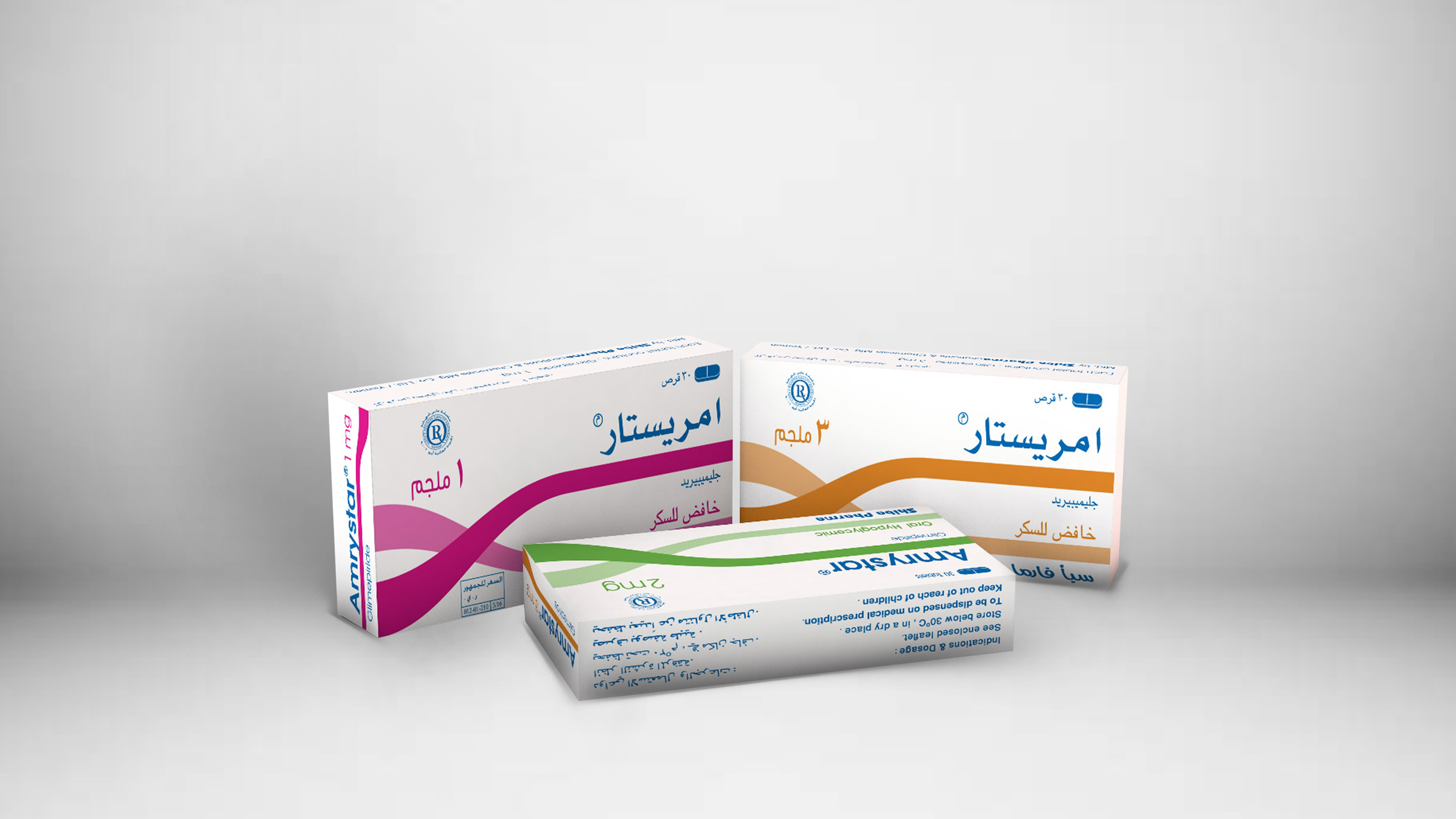Section :
Amrystar
Colour Information :
300 C
Black
COMPOSITION :
Each tablet contains : Glimepiride 1, 2, 3 or 4 mg
DESCRIPTION :
Amrystar ( Glimepiride) is a hypoglycemic agent from sulfonylurea group, it decreases blood (glucose) sugar by
stimulating insulin release from pancreatic beta cells. This effect is based on an improvement of responsiveness of
beta cells to the physiological glucose stimulus. Glimepiride improves the normal action of insulin on peripheral tissue
for glucose uptake. The maximum serum concentrations are reached 2.5 hours after oral dose intake, Glimepiride is
highly protein binding. The half-life is about 5 to 8 hours.
INDICATIONS :
Amrystar is used to decrease blood sugar in patients with non- insulin dependent (type 2) diabetes, when diet,
physical exercise and weight reduction are not adequate to control blood sugar level.
DOSAGE & ADMINISTRATION :
The dose depends on results of blood and urine sugar tests .Glimepiride is taken just before or with the first main meal
of the day (usually breakfast) or as prescribed by the physician, swallow the tablet with at least a half glass of water
without chewing or crushing . It is important not to leave out any meal when Glimepiride is taken. If a dose is
forgotten, this should not be corrected by increasing the next dose.
The initial dose and dose adjustment : 1mg of Glimepiride once daily as usual initial dose , it can be increased
gradually, at intervals of 1 to 2 weeks between each step , to 2, 3 , or 4 mg Glimepiride per day based on regular blood
sugar monitoring. The maximum dose is 6 mg per day.
Use of Glimepiride in combination with metformin: Glimepiride can be used with metformin when blood sugar
level is not adequately controlled with the maximum daily dose of metformin. While maintaining the metformin dose,
the Glimepiride therapy is started with a low dose, which is then titrated according to the desired blood sugar level
and the combination therapy should be initiated under close medical supervision.
Use of Glimepiride in combination with insulin : Glimepiride can be used with insulin when blood sugar level is not
adequately controlled with the maximum daily dose of Glimepiride. While maintaining the Glimepiride dose, the
insulin therapy is started with a low dose, which is then titrated according to the desired blood sugar level and the
combination therapy should be initiated under close medical supervision.
If the weight of the patient or the life -style is changed, the dose should be changed accordingly.
RESTRICTION ON USE :
Contraindications
- Hypersensitivity to Glimepiride, other sulfonylureas or other sulfonamides.
- Patients who have insulin–dependent (type 1) diabetes mellitus, diabetic ketoacidosis , coma or diabetic precoma .
- Patients with severe liver or renal impairment a change over to insulin is indicated to achieve optimal metabolic
control.
Precaution
- Diabetic patient should take care of factors that lead to hypoglycemia such as overdosage of Amrystar, malnutrition,
irregular mealtimes, missed or delayed meals , change in diet, drinking alcohol especially when skipped a meal ,
taking drugs that decreases blood sugar , imbalance between physical exercise and carbohydrate intake, disorder of
thyroid gland , pituitary gland or adrenal cortex , decreased kidney function and severe liver disease.
The Signs of hypoglycemia: Headache, hunger, nausea, vomiting , sluggishness , sleep disorders, restlessness,
aggression, impaired concentration , depression , speech and visual disorders, shakiness , partial paralysis, sweating,
dizziness , helplessness , clammy skin, accelerated heart beat , high blood pressure , palpitation ,cardiac arrhythmia.
If blood sugar level continue to fall ,patient may suffer from confusion ,breathing may be decreased and heart beat
slowed down , patient may fall into unconsciousness .
Treating hypoglycaemia : Immediate intake sugar or sweetener juice , whereas food or juices containing artificial
sweeteners have no effect. If taking sugar does not help, consult doctor immediately.
- Signs of hyperglycemia are : increase the frequency of urination, intense thirst, mouth dryness, skin dryness.
- The patient should be advised to do regular exercise and follow suitable diet in addition to the regular intake of
Glimepiride.
- Diabetic patient should inform any physician if there is any disease and drugs used before, in exceptional cases(such
as surgery and accidents , infection with fever) a temporary change of treatment to insulin may be necessary to
control blood sugar.
- Decreasing of the haemoglobin level and breakdown of red blood cells (haemolytic anemia) can occur in patients
with glucose-6-phosphate dehydrogenase enzyme deficiency .
- Amrystar is not recommended for use in children below 18 years of age.
- The level of sugar in blood and urine should be checked regularly, blood cell levels and liver function should be
monitored.
- Amrystar contains lactose , so it should not be given to patients with hereditary problems of galactose intolerance or
glucose – galactose malabsorption .
Effects on the ability of driving vehicles and using machines
Ability to concentrate or react may be reduced in diabetic patient if blood sugar is decreased (hypoglycaemia), or
increased (hyperglycaemia),as a result there is risk to the patient and others when driving or using machines.
Use in Pregnancy and lactation
Amrystar should not be used by pregnant women , women planning to get pregnant or lactating women ,they should
consult the doctor to change over to insulin.
DRUGS INTERACTIONS :
- Co–administration with drugs which increase effect of Glimepiride lead to decrease level of blood sugar than the
normal level such as : insulin and oral antidiabetics, ACE inhibitors, male sex hormones , coumarin derivatives such
as warfarin, fenfluramine, Fibrates, fluoxetine, MAO inhibitors, Ifosfamide , cyclophosphamide, trofosfamide,
pentoxifylline , phenylbutazone , azopropazone ,oxyphenbutazone , aspirin like medicines, probenecid ,
sulfinpyrazone , allopurinol, some long acting sulfonamides , tetracyclines , chloramphenicol, quinolones,
fluconazole, miconazole , clarithromycin , tritoqualine , sympatholytic agents that used to treat high blood pressure ,
heart failure or prostate symptoms .
- Co–administration with drugs which decrease effect of Glimepiride lead to increase level of blood sugar than the
normal level such as : acetazolamide, barbiturates, corticosteroids, diazoxide, diuretics, adrenaline and other
sympathomimetic agents , glucagon, laxatives , nicotinic acid , oestrogens and progestogens, phenothiazine
derivatives , phenytoin, rifampicin, thyroid hormones such as levothyroxine .
- Co–administration with the following drugs lead to increase or decrease blood sugar lowering effect of Glimepiride
such as H2 receptor antagonist, reserpine, Beta-blockers, clonidine, guanethidine .These can also hide the signs of
hypoglycemia . Chronic and acute alcohol intake may increase or decrease the blood sugar lowering effect of
Glimepiride in an unpredictable way. Glimepiride may either increase or weaken the effects of inhibiting blood
clotting drugs such as coumarin derivatives .
ADVERSE EFFECTS :
Rare side effects : Decrease in blood sugar level than normal level ,decrease in the number of blood cells.
Very rare side effects: Allergic reactions including skin rash and pruritus which may develop into serious reactions
with difficulty in breathing and fall in blood pressure, abnormal liver function including jaundice or hepatitis, nausea,
diarrhea, abdominal pain, decrease in sodium level in the blood.
Other side effects may occur such as temporary visual problems at the beginning of treatment ,due to changes in
blood sugar levels ,increased the sensitivity of skin to sun .
OVERDOSAGE:
Symptoms : Nausea , vomiting , epigastric pain , hypoglycemic may be accompanied by restlessness, tremor ,
visual disturbances , somnolence, in severe cases convulsions and coma .
Treatment: overdose may lead to life-threatening hypoglycaemia and may require immediate treatment and
hospitalization even as a precautionary measure. In mild cases of hypoglycaemia can usually be treated with oral
carbohydrates or inducing vomiting to decrease the absorption of drug then drinking water or lemon juice with
activated charcoal and sodium sulphate (laxative) .If a large quantity has been ingested , gastric lavage should be
done followed by taking activated charcoal and sodium sulphate . In more severe cases accompanied by loss of
consciousness and convulsions or neurological impairment the patient may be treated with 50 ml of a 50% glucose
solution IV as soon as possible followed by 10% IV infusion with strict monitoring of blood sugar level.
STORAGE INSTRUCTIONS :
Store below 30°C, in a dry place.
PRESENTATION :
Amrystar 1 mg : Blister pack of 30 tablets & hospital packs of different sizes.
Amrystar 2 mg : Blister pack of 30 tablets & hospital packs of different sizes.
Amrystar 3 mg : Blister pack of 30 tablets & hospital packs of different sizes.
Amrystar 4 mg : Blister pack of 30 tablets & hospital packs of different sizes.
Mfd. By
P.O. Box : 4265 Sana’a /Yemen.
INSTRUCTIONS TO THE PATIENT
- Medicament is a product which affects your health, and its consumption contrary to instructions is dangerous for you.
- Follow strictly the doctor’s prescription, the method of use and the instructions of the pharmacist who sold the medicament.
- The doctor and the pharmacist are experts in medicine, its benefits and risks.
- Do not by yourself interrupt the period of treatment prescribed for you.
- Do not repeat the same prescription without consulting your doctor.
Keep medicament out of reach of children
Council of Arab Health Ministers
012-06-113 2/17 Union of Arab Pharmacists


